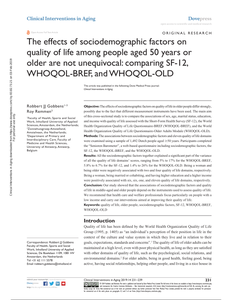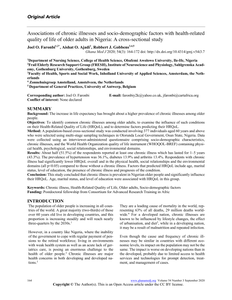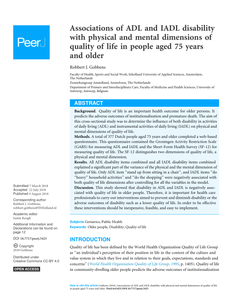Abstract Background: To assess the internal consistency reliability and construct validity of the Dutch version of the World Health Organization Quality of Life Instrument-Older Adults Module (WHOQOL-OLD). Methods: The psychometric properties of the Dutch WHOQOL-OLD were examined in a cross-sectional study using a sample of 1,340 people aged 60 years or older. Participants completed a Web-based questionnaire, the ‘Senioren Barometer’. Reliability was evaluated using Cronbach’s alpha and corrected item-total correlations. Construct validity of the Dutch WHOQOL-OLD was evaluated with confirmatory factor analyses, and correlations within and between scales, using scales WHOQOL-BREF, Short Form Health Survey (SF-12), Tilburg Frailty Indicator (TFI), and the Emotional and Social Loneliness Scale (ESLS).
DOCUMENT

Objective: The effects of sociodemographic factors on quality of life in older people differ strongly, possibly due to the fact that different measurement instruments have been used. The main aim of this cross-sectional study is to compare the associations of sex, age, marital status, education, and income with quality of life assessed with the Short-Form Health Survey (SF-12), the World Health Organization Quality of Life Questionnaire-BREF (WHOQOL-BREF), and the World Health Organization Quality of Life Questionnaire-Older Adults Module (WHOQOL-OLD). Methods: The associations between sociodemographic factors and eleven quality of life domains were examined using a sample of 1,492 Dutch people aged $50 years. Participants completed the “Senioren Barometer”, a web-based questionnaire including sociodemographic factors, the SF-12, the WHOQOL-BREF, and the WHOQOL-OLD. Results: All the sociodemographic factors together explained a significant part of the variance of all the quality of life domains’ scores, ranging from 5% to 17% for the WHOQOL-BREF, 5.8% to 6.7% for the SF-12, and 1.4% to 26% for the WHOQOL-OLD. Being a woman and being older were negatively associated with two and four quality of life domains, respectively. Being a woman, being married or cohabiting, and having higher education and a higher income were positively associated with six, six, one, and eleven quality of life domains, respectively. Conclusion: Our study showed that the associations of sociodemographic factors and quality of life in middle-aged and older people depend on the instruments used to assess quality of life. We recommend that health care and welfare professionals focus particularly on people with a low income and carry out interventions aimed at improving their quality of life.
DOCUMENT

De publicatielijst bevat alle publicaties waar Robbert Gobbens aan bijgedragen heeft in de periode 2005 - 2020
DOCUMENT

Objective: The aim of this cross-sectional study was to determine the associations between frailty and multimorbidity on the one hand and quality of life on the other in community-dwelling older people. Methods: A questionnaire was sent to all people aged 70 years and older belonging to a general practice in the Netherlands; 241 persons completed the questionnaire (response rate 47.5%). For determining multimorbidity, nine chronic diseases were examined by self-report. Frailty was assessed by the Tilburg Frailty Indicator, and quality of life was assessed by the World Health Organization Quality of Life Instrument—Older Adults Module. Results: Multimorbidity, physical, psychological, as well as social frailty components were negatively associated with quality of life. Multimorbidity and all 15 frailty components together explained 11.6% and 36.5% of the variance of the score on quality of life, respectively. Conclusion: Health care professionals should focus their interventions on the physical, psychological, and social domains of human functioning. Interprofessional cooperation between health care professionals and welfare professionals seems necessary to be able to meet the needs of frail older people.
DOCUMENT

Background: The increase in life expectancy has brought about a higher prevalence of chronic illnesses among older people. Objectives: To identify common chronic illnesses among older adults, to examine the influence of such conditions on their Health-Related Quality of Life (HRQoL), and to determine factors predicting their HRQoL. Method: A population-based cross-sectional study was conducted involving 377 individuals aged 60 years and above who were selected using multi-stage sampling techniques in Olorunda Local Government, Osun State, Nigeria. Data were collected using an interviewer-administered questionnaire comprising socio-demographic characteristics, chronic illnesses, and the World Health Organization quality of life instrument (WHOQOL-BREF) containing physical health, psychological, social relationships, and environmental domains. Results: About half (51.5%) of the respondents reported at least one chronic illness which has lasted for 1–5 years (43.3%). The prevalence of hypertension was 36.1%, diabetes 13.9% and arthritis 13.4%. Respondents with chronic illness had significantly lower HRQoL overall and in the physical health, social relationships and the environmental domains (all p<0.05) compared to those without a chronic illness. Factors that predicted HRQoL include age, marital status, level of education, the presence of chronic illness and prognosis of the condition. Conclusion: This study concluded that chronic illness is prevalent in Nigerian older people and significantly influence their HRQoL. Age, marital status, and level of education were associated with HRQoL in this group.
DOCUMENT

Abstract Purpose To determine the predictive value of quality of life for mortality at the domain and item levels. Methods This longitudinal study was carried out in a sample of 479 Dutch people aged 75 years or older living independently, using a follow-up of 7 years. Participants completed a self-report questionnaire. Quality of life was assessed with the WHOQOL-BREF, including four domains: physical health, psychological, social relationships, and environment. The municipality of Roosendaal (a town in the Netherlands) indicated the dates of death of the individuals. Results Based on mean, all quality of life domains predicted mortality adjusted for gender, age, marital status, education, and income. The hazard ratios ranged from 0.811 (psychological) to 0.933 (social relationships). The areas under the curve (AUCs) of the four domains were 0.730 (physical health), 0.723 (psychological), 0.693 (social relationships), and 0.700 (environment). In all quality of life domains, at least one item predicted mortality (adjusted). Conclusion Our study showed that all four quality of life domains belonging to the WHOQOL-BREF predict mortality in a sample of Dutch community-dwelling older people using a follow-up period of 7 years. Two AUCs were above threshold (psychological, physical health). The findings offer health care and welfare professionals evidence for conducting interventions to reduce the risk of premature death.
DOCUMENT

Background. Quality of life is an important health outcome for older persons. It predicts the adverse outcomes of institutionalization and premature death. The aim of this cross-sectional study was to determine the influence of both disability in activities of daily living (ADL) and instrumental activities of daily living (IADL) on physical and mental dimensions of quality of life. Methods. A total of 377 Dutch people aged 75 years and older completed a web-based questionnaire. This questionnaire contained the Groningen Activity Restriction Scale (GARS) for measuring ADL and IADL and the Short-Form Health Survey (SF-12) for measuring quality of life. The SF-12 distinguishes two dimensions of quality of life, a physical and mental dimension.
DOCUMENT

Objective: The Tilburg Frailty Instrument (TFI) is an instrument for assessing frailty in community-dwelling older people. Since its development, many studies have been carried out examining the psychometric properties. The aim of this study was to provide a review of the main findings with regard to the reliability and validity of the TFI. Methods: We conducted a literature search in the PubMed and CINAHL databases on May 30, 2020. An inclusion criterion was the use of the entire TFI, part B, referring to the 15 components. No restrictions were placed on language or year of publication. Results: In total, 27 studies reported about the psychometric properties of the TFI. By far, most of the studies (n = 25) were focused on community-dwelling older people. Many studies showed that the internal consistency and test–retest reliability are good, which also applies for the criterion and construct validity. In many studies, adverse outcomes of interest were disability, increased health-care utilization, lower quality of life, and mortality. Regarding disability, studies predominantly show results that are excellent, with an area under the curve (AUC) >0.80. In addition, the TFI showed good associations with lower quality of life and the findings concerning mortality were at least acceptable. However, the association of the TFI with some indicators of health-care utilization can be indicated as poor (eg, visits to a general practitioner, hospitalization). Conclusion: Since population aging is occurring all over the world, it is important that the TFI is available and well known that it is a user-friendly instrument for assessing frailty and its psychometric properties being qualified as good. The findings of this assessment can support health-care professionals in selecting interventions to reduce frailty and delay its adverse outcomes, such as disability and lower quality of life.
DOCUMENT

Abstract Background: People with severe mental illness (SMI) often suffer from long-lasting symptoms that negatively influence their social functioning, their ability to live a meaningful life, and participation in society. Interventions aimed at increasing physical activity can improve social functioning, but people with SMI experience multiple barriers to becoming physically active. Besides, the implementation of physical activity interventions in day-to-day practice is difficult. In this study, we aim to evaluate the effectiveness and implementation of a physical activity intervention to improve social functioning, mental and physical health. Methods: In this pragmatic stepped wedge cluster randomized controlled trial we aim to include 100 people with SMI and their mental health workers from a supported housing organization. The intervention focuses on increasing physical activity by implementing group sports activities, active guidance meetings, and a serious game to set physical activity goals. We aim to decrease barriers to physical activity through active involvement of the mental health workers, lifestyle courses, and a medication review. Participating locations will be divided into four clusters and randomization will decide the start of the intervention. The primary outcome is social functioning. Secondary outcomes are quality of life, symptom severity, physical activity, cardiometabolic risk factors, cardiorespiratory fitness, and movement disturbances with specific attention to postural adjustment and movement sequencing in gait. In addition, we will assess the implementation by conducting semi-structured interviews with location managers and mental health workers and analyze them by direct content analysis. Discussion: This trial is innovative since it aims to improve social functioning in people with SMI through a physical activity intervention which aims to lower barriers to becoming physically active in a real-life setting. The strength of this trial is that we will also evaluate the implementation of the intervention. Limitations of this study are the risk of poor implementation of the intervention, and bias due to the inclusion of a medication review in the intervention that might impact outcomes. Trial registration: This trial was registered prospectively in The Netherlands Trial Register (NTR) as NTR NL9163 on December 20, 2020. As the The Netherlands Trial Register is no longer available, the trial can now be found in the International Clinical Trial Registry Platform via: https:// trial search. who. int/ Trial2. aspx? Trial ID= NL9163.
DOCUMENT

Background: Previous studies found that 40-60% of the sarcoidosis patients suffer from small fiber neuropathy (SFN), substantially affecting quality of life. SFN is difficult to diagnose, as a gold standard is still lacking. The need for an easily administered screening instrument to identify sarcoidosis-associated SFN symptoms led to the development of the SFN Screening List (SFNSL). The usefulness of any questionnaire in clinical management and research trials depends on its interpretability. Obtaining a clinically relevant change score on a questionnaire requires that the smallest detectable change (SDC) and minimal important difference (MID) are known. Objectives: The aim of this study was to determine the SDC and MID for the SFNSL in patients with sarcoidosis. Methods: Patients with neurosarcoidosis and/or sarcoidosis-associated SFN symptoms (N=138) included in the online Dutch Neurosarcoidosis Registry participated in a prospective, longitudinal study. Anchor-based and distribution-based methods were used to estimate the MID and SDC, respectively. Results: The SFNSL was completed both at baseline and at 6-months’ follow-up by 89/138 patients. A marginal ROC curve (0.6) indicated cut-off values of 3.5 points, with 73% sensitivity and 49% specificity for change. The SDC was 11.8 points. Conclusions: The MID on the SFNSL is 3.5 points for a clinically relevant change over a 6-month period. The MID can be used in the follow-up and management of SFN-associated symptoms in patients with sarcoidosis, though with some caution as the SDC was found to be higher.
DOCUMENT
